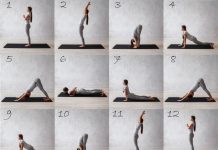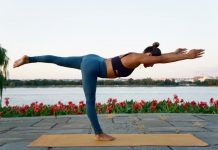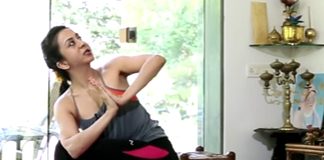Shirshasana (headstand) may not be your most favorite yoga pose, but did you know that it offers numerous health benefits? It promotes blood circulation in the brain and increased brain function, soaking brain cells with fresh blood, oxygen and nutrients. It also balances the nervous system. Various studies have found that yogists who consistently practice this gravity-defying pose are not risk to ischemic stroke. And most notably, it strengthens the neck, shoulders and arms. So, consider adding these three headstand poses from the second series of Ashtanga Yoga in your routine.
Bound Headstand – Baddha Hasta Sirsasana
If this is your first time doing a headstand, try doing this pose in front of a wall or with a friend who can assist you.
Begin by standing in all fours – hands and knees on the mat. Then lower your elbows to the flow and interlace your fingers securely.
Move the back of your head against your palm, and place the top of your head against the mat. Make sure that that your head and arms feel stable. Then, straighten your legs, walk your feet towards your face as closer you can get, and slowly shift your hips’ position over your shoulders with your elbows firmly planted on the mat. Lift one leg up straight up, and then work on lifting your another leg too to complete the headstand. Work on your balance and try to stay in this position for as long as you can.
Foreram Headstand – Pincha Mayurasana
For this pose, you need a strong upper body and a solid core, as well as open shoulders and hamstring.
To open your chest and shoulders, begin by sitting on your shins with your hands interlaced behind you in a double fist. Pull you pressed palms towards the floor, opening your chest and shoulders. Release your hand after five breaths and relax. Now you are ready to perform the forearm headstand.
From all fours, place your forearms on floor, shoulder distance apart. Then tuck your toes, lift your hips toward the ceiling, and straighten your legs. Tuck your head in between your shoulders with your forehead touching the ground, and slowly move your feet towards your elbows as far as you can. From this position, lift your right leg towards the ceiling, inhale and exhale five times, and stabilize your position. Raise another leg up, rocking forward, and eventually lift both feet off the ground. Stay in this position for five breaths.
Tripod Headstand – Mukta Hasta Sirsasana
This is the easiest headstand to learn among the three since you can use your hands to offer stability.
Begin in a plank position. Your shoulders should be stacked above your wrist. Your heels, hips and shoulders should be aligned. Thrust your pelvis forward – legs straight, toes curl under, the top of your head resting firmly on the floor, and hips above your shoulders. Walk your toes towards your face with your shoulders taking the weight to prevent exerting pressure on the head and neck. Take five breaths, then pick up your right leg and bend your knee, placing it lightly on your right triceps. Do the same using your left leg. Now, both of your knees should be bended and nesting slightly on your triceps.
From this position, slowly lift your hips and legs straight towards the ceiling. Maintain your center of gravity by staying compact as much as possible.
47 Most Famous Motivational Quotes of All-Time
49 Greatest Love Quotes
37 Inspirational Quotes that Will Change Your Life






























